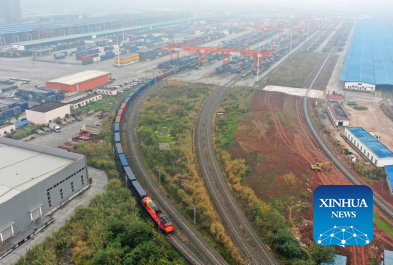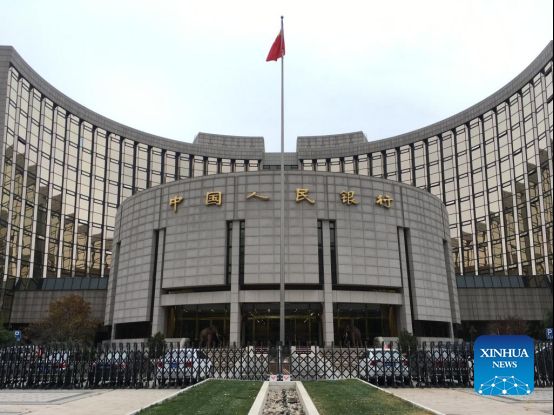China’s economy remains resilient in the long run in spite of challenges from COVID-19 pandemic, international financial institutions said. In reports and data released recently, they cited three reasons for optimism on China’s economy.
Reason 1: limited impact on China’s foreign trade
German trade with China in April was little affected by COVID-19 lockdowns and consequent disarray in supply chains, according to the Federal Statistics Office of Germany.
Germany imported 16.7 billion euros (17.5 billion U.S. dollars) worth of goods from China in April, up 52.8% from a year earlier, and importation of chemical products, up six-fold, particularly drove the increase, but other product groups also rose considerably, the German statistics office said.

Aerial photo shows a China-Europe freight train bound for Duisburg of Germany departing from Tuanjiecun Station in southwest China's Chongqing, Jan. 1, 2021. (Xinhua/Tang Yi)
China’s foreign trade has continued to grow despiteresurgenceof Omicron virus in major cities, such as Beijing and Shanghai.
In the first five months of 2022, China’s foreign trade volume gained 8.3 percent year on year to 16.04 trillion yuan (about 2.4 trillion U.S. dollars), according to the General Administration of Customs.
From January to May, China's trade with its top three trading partners -- the Association of Southeast Asian Nations, the European Union and the United States -- expanded by 8.1 percent, 7 percent and 10.1 percent from a year ago, respectively.
Reason 2: China’s long-term prospects remain intact
Key headwinds -- such as Omicron outbreaks, tight fiscal policy and strict regulations -- are cyclical rather than structural, meaning that China’s long-term prospects remain intact, Tilmann Galler, Executive Director at JPMorgan Asset Management,was quoted by CNBC as saying.
“The People’s Bank of China – compared to other central banks in Europe and North America – they have the flexibility to be more supportive for the economy,” Galler said at JPMorgan’s annual media event in London on June 8.
“There is more government support. Now, there is more money earmarked for railway, infrastructure investment, airport investment, tax cuts, purchase incentivization for cars, for the car market that is reeling at the moment,” he added.
“Chinese equities are beginning to look more attractive,” Galler said.

The People's Bank of China (PBOC), China's central bank. (Xinhua)
Myles Bradshaw, head of global aggregate fixed income strategies at JPMorgan Asset Management, said Chinese government debt was the most exciting pocket of global markets at the moment.
“The economy is slowing, interest rates have gone up, they haven’t eased monetary policy. It’s a great diversifier for your European, U.S. fixed income,” Bradshaw said.
Reason 3: China’s green economy has huge potential
China’s green finance could be a key revenue engine for banks in the next 10 years, according to a report from the UBS Group AG.
Green loans and green bonds, two major forms of financing, are expected to evolve into a 62-trillion-yuan (about 9.17 trillion U.S. dollars) and 8-trillion-yuan (about 1.18 trillion U.S. dollars) market in 2031. By then, it will contribute 15 percent of the banking system's total revenue, according to the report.
“China's green finance business is a market still in its infancy, but it will see vast growth opportunities in the coming decade,” analysts said in the report.
China's new-energy vehicle (NEV) market is in the spotlight of the global automobile industry, with its sales ranking first globally for a seventh straight year in 2021.
The size of China's NEV market is expected to top 5.22 million units this year, a surge of 47.2 percent over the previous year. And it’s likely to expand at a compound annual growth rate of around 38 percent from 2021 to 2025, with the total market size reaching 12.99 million units in 2025, according to a report released by global market research firm International Data Corporation (IDC).

A driver charges an electric car at a shared electric bus charging station in Qingdao, east China's Shandong Province, May 11, 2022. (Xinhua/Li Ziheng)
Growth momentum of China’s economy is expected to rebound in the second half of 2022, the World Bank said.
“If the pandemic is brought under control and domestic restrictions are fully lifted, full year growth could be higher than currently projected, thanks to the recently announced additional stimulus measures,” said The China Economic Update -- June 2022, a report published by the World Bank on June 8.



